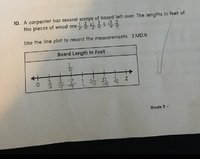cbonilla8890
New member
- Joined
- Mar 27, 2019
- Messages
- 7
I'm helping someone in 3rd grade solve a fraction problem.
Note: The one from the QUESTION is already in the plot below, and there are 3 spaces before the 1 and 3 spaces after the 1. This makes it 7 fractions in the question. I'm so confused in what is supposed to be a simple question.
Any help would be much appreciated! Thanks!
A carpenter has several scraps of board left over.The lengths in feet of the pieces of woods are 1/2, 2,4, 1 and 1/2, 3/4, 1, 1 3/4, 3/4
Use the line plot to record the measurements
0 __________ 1____________ 2
Note: The one from the QUESTION is already in the plot below, and there are 3 spaces before the 1 and 3 spaces after the 1. This makes it 7 fractions in the question. I'm so confused in what is supposed to be a simple question.
Any help would be much appreciated! Thanks!
A carpenter has several scraps of board left over.The lengths in feet of the pieces of woods are 1/2, 2,4, 1 and 1/2, 3/4, 1, 1 3/4, 3/4
Use the line plot to record the measurements
0 __________ 1____________ 2

